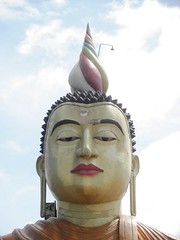I take a lot of day trips. Firstly because I like to get a change of scenery and visit places off the beaten track, and secondly because I enjoy the lengthy bus rides which combine an excursion into the tranquility of the Indian countryside with a near-constant risk of violent death.
The title of this post is misleading. There is no one single Bus Of Death. Each and every bus is a rolling box perfectly equipped for mass homicide. Where the rear-view mirror should say "Objects in the mirror are closer than they appear", it instead reflects a haunting message that reads "redrum...REDRUM." You could just take two and a half hours of barely-edited footage from an Indian bus and title it "Saw VII: Kota to Indore". This is especially true of routes along secondary highways, which are usually about one and a half lanes wide are are trafficked not only by the customary ramshackle slew of motor vehicles but also by creaking bullock-carts and plodding pregnant cows which need to be overtaken, resulting in a continuous game of Chicken with oncoming trucks and buses that is usually resolved in a blare of horns in a matter of only feet or inches.
Fearing that my delicate foreign senses would be offended by the cramped conditions in the main compartment, conductors usually invite me to sit on the bench in the driver's cabin. I happily accept their offers and relax in the space and safety of what I've come to think of endearingly as the "forward-firing ejector seat." The bus to Osiyan had an even more special feature: a large metal platform in the cabin that served no discernable purpose and pressed uncomfortably against my legs. I was grateful though for this minor discomfort as the edge of the platform would do a fabulous job of dispossessing me of my feet and my shins, which would otherwise become flailing hindrances to my projectile motion through the front window.
India is one of those many countries that is so accustomed to not having the capacity to solve problems that addressing problems without in any way solving them has become part of the national culture. It would be poor form to do nothing, so things are sometimes done that are worse than nothing at all. For instance, when there is a dangerous obstacle on the shoulder of the road causing a narrow space unsafe to pass in, local people helpfully mark these obstacles by placing piles of rocks in the road itself. If this were a country with landmines they would be marked off by spike strips.
Trucks and buses in India always have an idol on the dashboard, surrounded by small posters of Vishnu, Krishna, and so on stuck to the windshield. The idol is often a local town god you've never heard of, covered in beads and wreaths of flowers. Stepping onto this bus I saw the idol was Ganesh. You don't want to be on a bus devoted to Ganesh.
Ganesh is the elephant-headed god of luck, and is perhaps the most popularly worshiped of the Hindu gods. In a country so overpopulated that a person's skills or goods are almost guaranteed to be redundant, it is no surprise people perceive simple luck as the key to success. People who are especially devoted to Ganesh are dangerous: they believe they are favored by Chance. This obviates the need for Skill, Foresight, Acumen, and Caution.
So I saw this idol to Ganesh and I knew instantly our driver was consciously putting our lives in the hands of Fate. We were to play a game of Russian Roulette where the bullet would be a Tata truck and the revolver reloaded every minute. Fate, aided by the iron-willed determination of our driver in the face of oncoming traffic, granted us a heart-pounding but rapid passage to Osiyan.
Osiyan itself was not nearly as exciting as getting there. It's a smallish town out in the desert notable mostly for the age rather than the grandeur of its temples. I was excited to see a collection of 8th and 9th century temples mostly intact. The first, a large Hindu edifice to a god also worshiped by the Jains sat high on a raised platform. A local trader, who had nothing better to do because he lives in Osiyan, took it upon himself to give me a tour complete with a religious education.
Never put too much stock in a religious man's explanation of other people's religions. He strongly insisted that Jainism is a branch of Hinduism, while Jains are quick to assert that they're more like Buddhists ("but different religion!" they always add). The trader, whose name was Sarim, provided proof of his argument by stating that Jains worship five Hindu gods (one was Lakshmi, I forget the other four). "Well, five out of thirty million sounds like a pretty big difference" I quipped. "Just one is enough!" he replied.
The temple was interesting if not opulent, with a pleasant use of mirrors inside and ancient carvings outside. We went out on the roof and Sarim directed me immediately to the Kama Sutra carvings, which is what Indian men assume foreign tourists will find most interesting. Though this is frequently correct, it is a textbook case of projection if there ever was one. However, the erotic sculptures had all been defaced...literally. Armies in the 11th and 17th centuries under the commands of Mohamed of Ghazni and the Mughal Emperor Aurangzeb, respectively, had chiseled the faces off in keeping with the Muslim prohibition on the depiction of recognizable human figures. "The Heretics," as Sarim had thus far exclusively referred to Muslims, "they smash the heads". The result was a bizarre montage of figures in explicit acts of coitus, naked bodies and huge genitalia fully intact, though they had been gruesomely decapitated and were fornicating under the watch of other faceless, multi-limbed semi-human monsters and celestial entities. Little did I know that the people of ancient Rajasthan were avid readers of Japanese comics.
Sarim giddily honked on a pair of sandstone breasts, then ran his finger over the missing face and his expression turned dour. "It is always these Muhammad peoples" he muttered. "No fine works these Heretics."
We then went to the Jain Mahavira temple, which I was enthused about because Mahavira, the Buddha figure of Jainism, is the one part of the religion that seems to to be grounded on planet Earth and his teachings form the backbone of Jain ideology. This temple too was ancient and its main idol was a magnificent statue of Mahavira made of sand and milk and encased in gold 2000 years ago (and irritatingly off-limits to photography). There was a group of Gujarati Jain pilgrims in the temple, playing music and praying in copper crowns and cloth masks while the resident monks made formal offerings. I went to the back of the temple to peruse a montage of the life of Mahavira, which I expected to be a welcome relief from tales of 5-million year old tirthankaras. It was of course more complicated, as in addition to the life of Mahavira himself it mostly detailed the fantastical lives of the previous incarnations of his soul over the aeons, which found their coda in Mahavira's mortal life, attainment of ultimate truth, and ascension into the heavens.
Next I popped quickly over to some minor old temples and discovered why few people come to see Osiyan.: the age of the temples does not make them any less small and unremarkable. I also saw a deep, lushly-planted baori (step-well) and made my way back to the bus stand, where I was quite surprised to see a pair of peacocks chilling on the roof of a pharmacy. I had assumed that peacocks were like psychedelic turkeys or little blue emus, a bird only in the Linnaean sense of the word, but it turn out the bastards actually have some spring and can hop and flap their way up to a rooftop in only one or two steps. I eagerly wished to travel seven years into my past so that I could be smaller, kinap a peacock, take it to the top of a tall temple, and hang-glide Zelda-style about town as it squawks and flaps madly to carry me to obscure ledges filled with treasure. Then I realized that seven years ago I was sixteen and much the same size I am today so I was forced to discard this dream into the same sentimental rubbish bin as my scheme to travel India on a motorbike with a pet monkey poking out of my backpack.
my bus back to Jodhpur departed at sundown. I noted that the idol on the dash seemed to be a female fertility goddess. Good, I thought, the driver must be a family man. He wants to live. Above the idol was a row of colored lights that turned on periodically and sometimes began to flash rapidly. Seeing my interest (there was nothing else to look at in the dark except the lights of oncoming trucks) he explained that it was attached to a radar gun and the lights signaled the presence of an object directly ahead while the flashing indicated the speed at which a frontal collision was becoming imminent. I watched this device anxiously for much of the two-hour trip, and observed its frantic flashing in the face of a stream of approaching headlights. It was only late in the journey that I thought to count the cycles of flashes and time the intervals between their flashing, when I determined that the lights were actually just on a set pattern and were merely the typical bright crap that Indians like to decorate with. I felt foolish for believing him, but it was a convincing joke - collisions are imminent all the damn time. "Ha ha yes, is one pattern!" he laughed after I jovially accused him of his deceit.
Ha ha indeed. It's funny because every 45 seconds we almost died.
Nov 23, 2009
Subscribe to:
Post Comments (Atom)









No comments:
Post a Comment
Commenting Rules:
1)No spam, viruses, porn etc.
2)DO NOT POST GF-B's REAL NAME
3)Remember this is a public website, don't provide sensitive info about yourself in the internet!